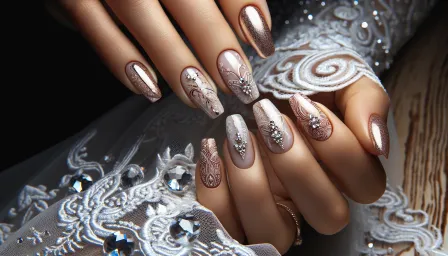The Ultimate Guide to Nail Extensions Types: Find Your Perfect Style

Discover the different types of nail extensions, their benefits, and how to choose the perfect style for you. Learn about acrylics, gels, and more!
Nail extensions have become a popular trend in the beauty industry, offering a myriad of choices for those seeking longer, more durable, and aesthetically pleasing nails. With so many types of nail extensions available, it can be daunting to choose the right one for your style and needs. In this comprehensive guide, we will explore the various [nail extensions types], their benefits, and how to find the perfect one for you.
Understanding the Basics of Nail Extensions
Before diving into the different types of nail extensions, it is essential to understand what nail extensions are and why they are so popular. Nail extensions are artificial structures placed over your natural nails, either to add length, enhance strength, or both. They can be customized to match your desired shape, length, and design, making them a favorite choice for both everyday wear and special occasions.
Types of Nail Extensions
Acrylic Nail Extensions
Acrylic nail extensions are among the most popular choices due to their durability and versatility. They consist of a combination of liquid monomer and powder polymer that forms a hard protective layer. Once applied and shaped, acrylic nails are air-cured and often finished with nail polish or other nail art. Benefits of acrylic extensions include:
- Long-lasting strength and durability
- Widely available and cost-effective
- Easy to repair if damaged
However, they require regular maintenance and can be damaging to natural nails if not applied or removed correctly.
Gel Nail Extensions
Gel extensions are known for their natural look and feel. They are applied using a gel-based substance that is cured under a UV or LED light. There are two main types of gel extensions: hard gel and soft gel (often referred to as gel polish). Hard gel extensions are more durable and can be used to add length, while soft gel is perfect for adding strength and maintaining a natural appearance. Key benefits include:
- Natural appearance and high-gloss finish
- Flexible and less prone to lifting
- Odorless application process
However, gel extensions can be more expensive than acrylics and require careful removal to avoid damaging the natural nails.
Silk Wrap Nail Extensions
Silk wrap extensions use pieces of silk fabric glued onto the nails to add strength and length. This type is less popular today but is still an excellent option for those with brittle or damaged nails. Silk wraps are thinner and lighter than both acrylic and gel extensions, offering a more natural feel. Advantages include:
- Gentle on natural nails
- Good for repairing splits or breaks
- Lightweight and natural appearance
On the downside, silk wraps are not as durable and may require frequent touch-ups to maintain their look.
Fiberglass Nail Extensions
Similar to silk wraps, fiberglass nail extensions use thin strands of fiberglass to reinforce the natural nails. These extensions are applied with a resin and can be shaped to the desired length. They are especially useful for those looking to strengthen weak nails without adding significant bulk. Benefits include:
- Natural feel and appearance
- Flexible and less prone to cracking
- Good for reinforcing natural nails
However, like silk wraps, fiberglass extensions may not last as long as acrylics or gels and require regular upkeep.
Choosing the Right Type for You
When selecting from the different [nail extensions types], consider the following factors:
Nail Condition
Examine the current condition of your natural nails. If your nails are brittle or weak, opt for gentler options like silk or fiberglass wraps. For those with stronger nails, acrylics or gels might be more suitable.
Lifestyle
Your daily activities play a significant role in determining the best type of nail extensions for you. If you frequently use your hands or engage in activities that might cause nail damage, choose durable options like acrylic or hard gel extensions.
Maintenance
Consider how much time and effort you are willing to invest in maintaining your nail extensions. Acrylics generally require more frequent fills and potential repairs, while gels and wraps may need gentler upkeep.
Budget
The cost of nail extensions varies significantly depending on the type and application method. Acrylics are typically the most affordable, while gels and silk wraps can be more expensive. Weigh your budget against the benefits of each type to make an informed decision.
Conclusion
Choosing the perfect type of nail extensions involves understanding your needs, preferences, and lifestyle. Whether you opt for the durability of acrylics, the flexibility of gels, or the gentleness of silk and fiberglass wraps, there is a nail extension type out there for everyone. We hope this guide has provided valuable insights into the different [nail extensions types] and will assist you in making an informed decision. Happy nail styling!



























